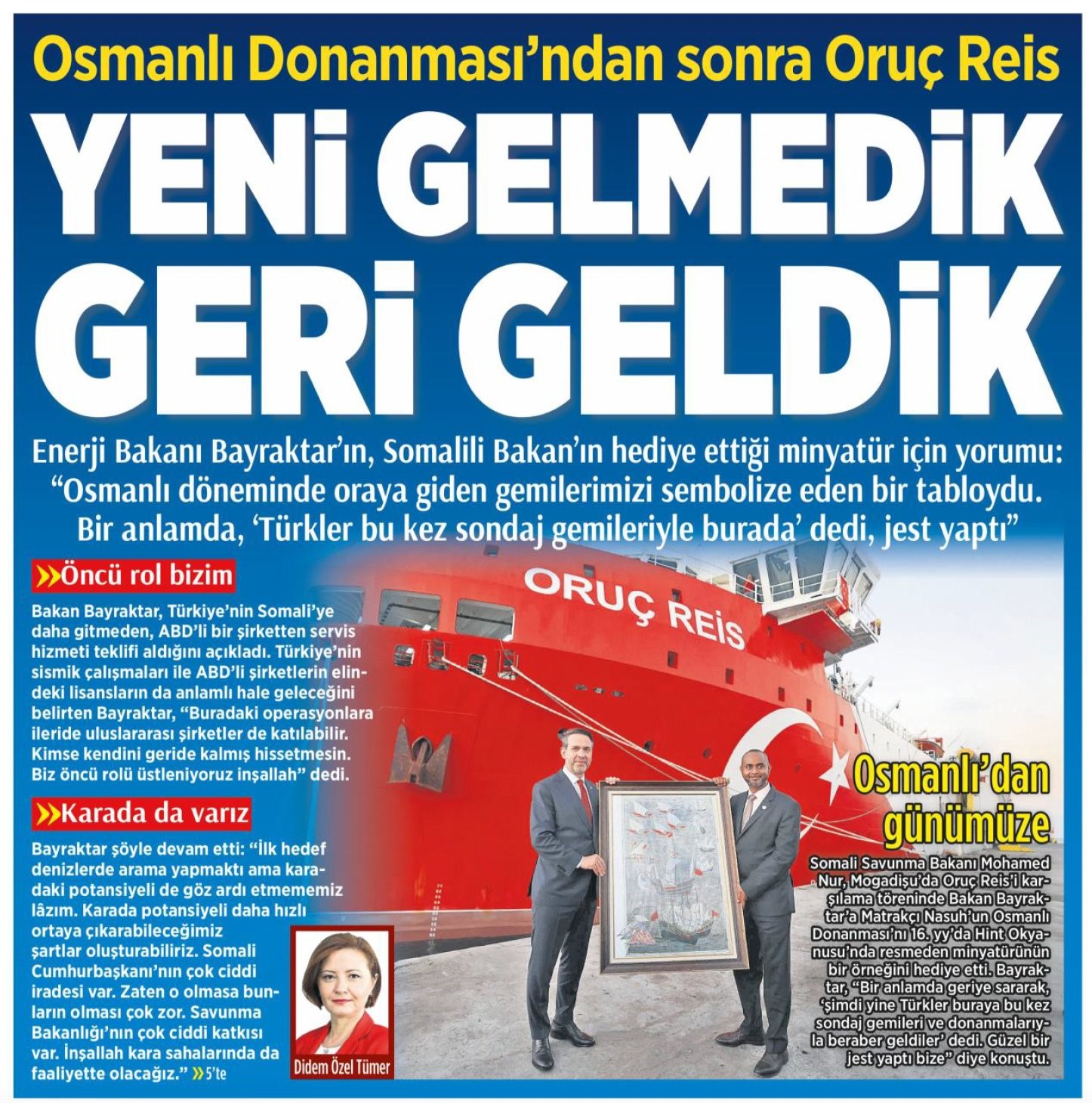Thursday 21 November 2024
Turkish press review: Oruç Reis in Somalia

Ebuzer Demirci reviews how Turkish media outlets covered the arrival of seismic research vessel Oruç Reis in Somali waters.
The arrival of Oruç Reis in Somali waters, escorted by the Turkish navy, was met with tremendous enthusiasm in Somalia. President Hassan Sheikh Mahmoud participated in a reception ceremony for the Turkish research vessel, during which he thanked the Turkish people and President Recep Tayyip Erdoğan for investing in developing relations with Somalia. “Today, you once again made a decision to strengthen the development, economy and power of Somalia,” he said.
Somalia’s defence minister, Abdulkadir Mohamed Nur, also attended the ceremony, where he welcomed Turkish energy minister Alparslan Bayraktar and presented him with a painting by a Somali artist depicting the Ottoman fleet operating in the Gulf of Aden against the Portuguese navy in the 16th century. In 2021, Nur shared a post on his X account, standing in front of the original painting.
This painting also highlights a significant facet of Somali statecraft. Often unfairly labelled a “failed state,” Somalia demonstrates strategic depth and foresight through gestures like these. At a time when Nur shared the post, Türkiye’s presence in the Indian Ocean was still a distant prospect but the tweet symbolised vision and intent, laying the foundation for a policy now coming to life with the Oruç Reis. The image of the Ottoman fleet safeguarding crucial maritime routes in the Gulf of Aden reflects the empire’s role as a protector of the region’s people, shielding them from external exploitation. For Somalis, this legacy serves as a proud reminder of an enduring bond with Türkiye, a connection highlighted in Nur’s post following the arrival of the Oruç Reis last week, which he described as the “symbol of our brotherhood beyond borders.”
This moment resonated strongly in Türkiye as well, with widespread media coverage capturing the excitement—akin to the unforgettable visit by President Erdoğan to Somalia in 2011. President Erdoğan saw the ship off and spoke to its captain, saying, “I believe that we will receive good news, God willing.” Anadolu Agency live-streamed the first stage of Oruç Reis’s journey through the Bosphorus. TRT World correspondent Kübra Akkoç noted that the ship was 100% domestically made, making it a “matter of national pride and unity” for Turkish audiences.
The story also made a splash in the Turkish newspapers, spawning several articles when the seismic research vessel eventually anchored at Mogadishu’s docks.
When Oruç Reis arrived, Yeni Şafak’s story looked at the impact it would have on Somalia, running with the headline: “Bringing hope to Somalia”. It noted that the work Oruç Reis was carrying out would hopefully help “Somalia will find more power within itself to regain its former glory and become the shining star of Africa”. Diriliş Postası covered the story in a similar way to Yeni Şafak. “ Oruç Reis brings hope to Somalia,” was its headline.
Sabah, a major newspaper in Türkiye, used the branding: “An energy project that makes history.” Okan Müderrisoğlu, a journalist and columnist and the author of another article on the story for Sabah, noted that the event marked a “first for Türkiye—not only in Turkish maritime history but also for the energy sector.” In a separate article covering the story, Müderrisoğlu focused on the reasons energy minister, Alparslan Bayraktar, described the Oruç Reis’s activities in Somali waters as a “game-changing move.” He wrote: “This is a project with implications far beyond opening a factory and employing a few hundred people. Why? Because the added value is very high from the moment you reach a certain scale in the oil and gas sector.”
Müderrisoğlu’s second report explained that, beyond drilling, Türkiye also had further responsibilities to ensure the agreement would be of maximum benefit to both parties, including improving the institutional structure of Somalia’s national petroleum company and educating young Somalis at Turkish universities in the fields of “fields of geophysics, geology, and engineering”. The goal would be to develop Somalia’s human capital, giving it greater agency and ownership over the use of its energy resources in the future.
One of the most compelling columns on the arrival of the Oruç Reis in Mogadishu was written by journalist Didem Özel Tümer for Milliyet, who addressed domestic critics of Türkiye’s energy exploration in Somalia with the bold headline: “We’re not new [here]; we’re back.” The tagline at the top of the article read: “After the Ottoman navy, Oruç Reis.” Tümer framed her interpretation of the event around the centuries-old historical ties between various sultanates and polities on the Somali peninsula and the Ottoman empire making a point that Türkiye’s presence in the Indian Ocean is one that has precedent.

In an article for Sabah, security expert Merve Seren addressed sceptics questioning why Türkiye has invested so heavily in its relationship with Somalia. Seren argued that, despite Türkiye’s absence from Somalia between 1991 and 2011, Ankara “has never been indifferent to security threats, natural disasters, or humanitarian crises in Somalia.” She identified four key areas in which Turkish national interests align with Mogadishu offering win-wins for both parties: maritime security, energy, fisheries, and the defence industry.
Finally, Takvim placed the arrival of the Oruç Reis within the broader context of Türkiye’s relationship with Africa. Although Turkish involvement across Africa is now well-established—from Senegal to Somalia and many countries in between—journalists at the paper viewed the start of seismic research in Somalia as a kind of new beginning headlining their story with: “Our opening to Africa”.







